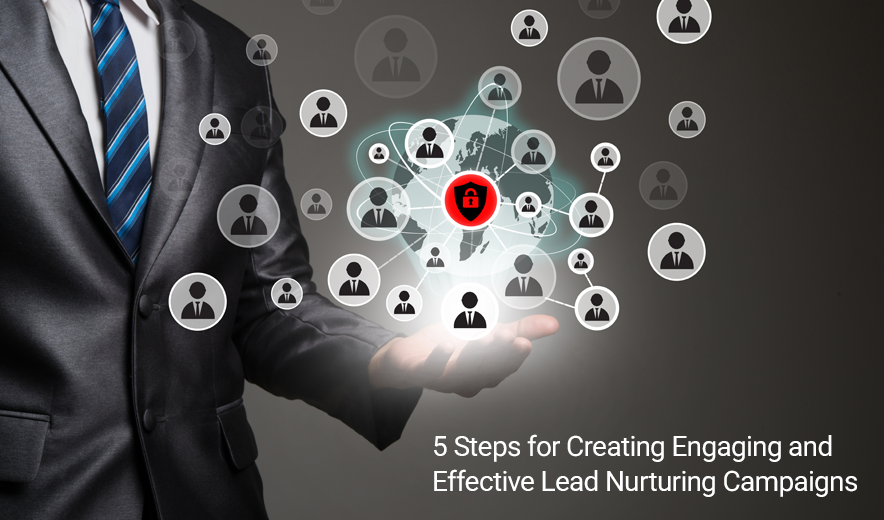The process of flourishing and reinforcing relationships with buyers at all stages of the sales funnel is known as lead nurturing. An effective lead nurturing program focuses on marketing and investing efforts in attentively understanding the needs of potential prospects. It provides answers and the information they require to increase brand awareness, build trust, and maintain a connection until prospects want to purchase. On average, half of the leads in any given system won’t be ready to buy. Hence, it’s essential to nurture relationships with buyers through a strategic lead-scoring system. Additionally, lengthening sales funnels encourages independence within prospects and creates a greater need for well-crafted lead nurturing programs.
Marketing automation platforms allow marketing teams to extend flexible, adaptive communications at scale by making a lead nurturing strategy. They design a pathway through which you can create relationships with potential customers and maintain those relationships while the prospect glides through the buyer’s journey at their own pace. You will increase click-through rates (CTRs), build lasting relationships, and enhance the propensity to purchase while building brand advocacy in creating a lead nurturing program. Lead nurturing campaigns let you interact with buyers, use the data you gather to measure their interest further and check behavior to increase return on investment (ROI) and optimize future campaigns.
Effective lead nurturing includes your entire marketing calendar to integrate the total amount of communications your leads are getting, including product updates, database emails, newsletters, and other cross-channel communications. It would be best if you focused on making these interactions work pleasantly to give customers the best possible experience and are relevant enough to earn your leads’ loyalty.
Lead nurturing tactics are the methods they use to nurture and re-engage leads effectively. It includes:
1. Email Nurturing
Most respondents say that email nurturing is the best way to re-engage leads. It is the most effective way to nurture leads because email marketing tools are very cost-effective compared to advertising. Additionally, you have the option to automate your email marketing campaigns., you can automate your email marketing campaigns.
While it is not ok to send too many emails, it is recommended to send one email per week with related content that leads may find interesting and use the right frequency and tools for email nurturing.
The most effective approach to enhancing email nurturing performance is by monitoring the progress of your ongoing campaigns. The key to email nurturing is to give super-practical and super-relevant content that regularly delivers real value to your leads.
A highly effective and efficient B2B lead nurturing strategy for 2023 involves combining email and video marketing. You can provide higher-quality video content by combining those two. After that, you can integrate with your CRM and marketing automation software to track how much time leads are spending on watching your videos. You can even utilize that data to set up triggers informing your sales teams of the most nurtured leads. Ultimately, data allows us to nurture leads effectively. There is a constant change in the best practices for sending emails, and data is taking all the guesswork out of it.
2. Retargeting
One of the ways to nurture leads is through retargeting and email marketing across multiple platforms. Retargeting combined with email newsletters ensures your brand stays at the top of the game. However, only a retargeting campaign isn’t enough; it must be planned appropriately. It can be the most successful way to convert leads into customers, but getting the conversion also needs a perfect sales funnel.
There are two ways to retarget your leads using display ads and social media, they are:
Social Media Retargeting: it is the only effective way to stay in front of leads. Also, the effectiveness of your ads depends on the social media site and the exact customer segment.
Display Retargeting: Also, one of the most effective ways to nurture leads. When the leads move through the buying journey, they begin seeing display ads that are significant to the stage they’re in. This way, you can still nurture leads with display ads even if you don’t have the email address for it. But it’s an excellent extra channel to reach leads on if you do have it.
3. Personalization
The brightest way to nurture leads is to pay attention to customer needs and wants and avoid sending templates and generic responses. Simply speaking, your interactions must be personalized when you are dealing with leads. You nurture leads when you personalize your interaction with them.
Here are three ways for improving your lead nurturing efforts with personalization:
Email Personalization
Lead nurturing aims to create a positive relationship with the client, and cultivating a personal rapport with them seems to be the most effective way to do it. It’s best to develop a series of basic email templates to personalize as much as possible when you are planning a campaign. You can add any unique details you know about the customer, like their interests or needs, and help build that relationship.
Content Personalization
Dynamic content is a good way to personalize content as it lets you show different versions of a web page, an email, or a landing page, depending on who will get it. You can then create just one campaign instead of setting up and configuring individual campaigns for each segment separately and trying to route leads into the best one. This will help you in saving time, track results, and deliver a personalized and seamless experience.
Direct Outreach Personalization
The way to nurture leads zeroes down to two tactics: dynamic content and contact cadence.
Contact cadence is a planned system for lead outreach that puts your brand top-of-mind. Achieve the desired outcomes by consistently employing a potent blend of dynamic content, phone calls, and various outreach methods spanning a duration of six to eight weeks. You want to reach out often enough that the audience remembers you, but not so much that you seem desperate or overbearing. Dynamic content aims at avoiding the use of standard scripts for phone and email outreach.
4. One-on-One Interactions
One-on-one conversations are the most personalized interactions with leads. People often forget how significant a true one-on-one touchpoint is and its impact on the automation process. Companies must include various personal touchpoints as part of the nurturing process. These personal interactions should be between the automatic processes and must be a part of the funnel rather than be outside it.
Here are three ways to have one-on-one interactions, they are:
– Meeting with leads in person.
– Connecting with leads on social media.
– Leaving nurturing to your sales development reps.
– Meeting with leads in person.
You must disconnect from technology if you want to focus on cultivating human relationships. Meeting for lunch or coffee can achieve so much more than social media posts, email exchanges, and more, as it’s an excellent way to know people.
Technology may help advance the conversation, but it cannot replace human interactions built over time. In today’s world, relevance and personalization always win deals. Marketing can be good for crafting relevant messaging, but it is not personal like one-to-one communication.
5. Content Marketing
Content marketing focuses on making valuable content and promoting it on the right channels. Once that happens, your content can become a lead magnet that helps your business flourish. Content is still king. Sending out valuable and relevant content to your prospects that really helps them without bragging and boasting about your successes and services is the best way to nurture a lead. Content is the best way to prove to prospects that you know your stuff. It helps in building trust and a quality reputation.
Conclusion
Whether you’re running a B2C or B2B business, launching a carefully planned lead nurturing campaign can help you convert more customers and boost sales significantly. You must develop a clear understanding of your target market by increasing a buyer persona made of data gathered from interviews and surveys.
Align your marketing and sales teams so they can decide which behaviors to track. Also, have a unified understanding of what a qualified lead should look like. That way, they can aid each other in doing their jobs better.
It’s not wise to limit yourself to email marketing. Even though it is effective, realize that your customers are also using different channels to research possible solutions online. Ensure that you include these channels in your lead nurturing campaign. This will help you to stay in the minds of your potential customers. It will also help you in retargeting and reminding those that abandoned their shopping carts. It will also increase your chances of getting them back and completing their purchase.
Above all, ensure that you provide content to your leads filled with personalized value depending on what stage they are in the marketing funnel. This will guarantee that you’re sending the right content at the right time. It will also help you persuade them to move through your marketing funnel more rapidly, decreasing the sales cycle and converting them into customers.
By following these strategies, you can convert more leads to customers and boost sales. Start by choosing a single approach and then apply this to your current inbound marketing plan. Assess and check the results before going to the next. You’ll see a surge in sales and the number of customers in your business.
Be a part of our community for free and access the best resources, trends, and new technologies from peers and industry experts. You can also check out our other awesome blogs over here.





